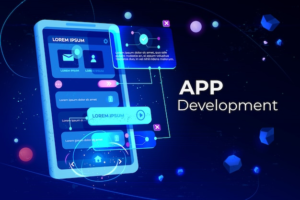The most prominent question is: What is the best approach to developing robust e-commerce apps? This blog covers the basic considerations that you need to keep in mind when deciding whether to add an app to your website and e-commerce business.
The Rationale Behind App Development for E-Commerce Businesses:
Developing e-commerce apps that can be accessed and operated from anywhere and at any time is a necessary asset for the efficient performance of any business today. Since retail is mostly done through mobile and online channels, apps can add tremendous value to the chain of events that control business transactions.
Types of eCommerce Apps:
Smartphones for shopping have propelled mobile commerce (m-commerce) to the platform and have proven to be a consistent driver for businesses. The mantra of success has introduced a new dimension for businesses to make money. Mobile apps have brought everlasting connectivity to customers. Customers can now visit their favorite stores and place orders at any time.
Based on the different models that exist within your business, different apps support your operations. Applications developed to meet specific business objectives and achieve goals are differentiated based on features, not just functionality.
Here we will discuss the different types of e-commerce applications developed to facilitate various activities.
- B2B e-commerce applications:
Applications that enable business transactions through an interface fall into this category. Goods and services can be exchanged through mobile channels, supporting large-scale transactions for high-volume exchanges.
Alibaba, Amazon Business, and Quill are examples of industries that sell to retailers, who in turn sell to consumers. Therefore, products sold here can become raw materials or items of sale for other industries in the future.
- B2C e-commerce applications:
Applications developed to complement the B2C model consume the company on one hand and the end users of the product on the other. Sales are made directly through the application channels. Amazon and Domino are examples of such e-commerce applications.
These apps give consumers direct access to all products offered by a company, while retailers may limit inventory and variety when selling multiple brands.
- C2B eCommerce Apps:
Businesses are also buyers of niche-specific products, such as content, design, and technology assets. C2B apps like Clutch and GitHub are platforms for subject matter experts to showcase their talents and build business relationships.
We encourage businesses to generate their profits on such purchases and strengthen the practice of sharing valuable talent through such channels.
- C2C e-commerce app:
C2C-type models work through mobile apps when consumers exchange products, services, or amenities with each other without going through a business or company.
Apps like OLX and eBay, which allow consumers to sell their products to other people like them, encourage such buying and selling and enable connections between broader user bases such as Masu communities.

- Other types of apps:
Ticket booking e-commerce app:
These e-commerce apps serve to book taxis, hotels, live shows, games, travel, professional or social events, and parties. Organizers use the app to share details of their activities and interested parties can purchase tickets or passes by making a payment through the app interface.
Goibibo and Momondo are popular examples of ticket-booking apps. Other similar e-commerce apps allow the exchange of goods directly between organizers, event managers, and end users.
e-commerce aggregator app:
Mobile apps that create connections between end customers and service providers like Walmart Inc. and Etsy Inc. are aggregator e-commerce apps. These apps tend to provide a platform for service providers to list their offerings, items, or products, which buyers can purchase or avail from within the app’s interface.
The app owners themselves do not provide any of the listed services and do not require any infrastructure setup, but they do publicize the services of sellers who join the app for their businesses.
When developing an e-commerce app, certain components are common to the various types listed above. These components contribute to the smooth running of your app.

e-commerce app development components:
Developing an e-commerce app is a guided process. The business objective or goal you want to achieve will determine what you include and in what format. However, certain elements are common to all e-commerce apps.
Below, we will discuss important components that will help you build an app to perform Full Circle functionality efficiently.
- Multimedia Content:
The different types of content, text, images, videos, graphics, and even audio that run within eCommerce apps facilitate the user journey through the app and constitute multimedia content. These are the main reasons why users are hooked to the app and transact on it.
Content created to mimic the interaction between two humans is responsible for building customer loyalty and conversions on your app.
- Content Storage Server:
You need to install a server that is powerful enough to support a large amount of diverse content. Digital content is delivered to the user and received with important information about the user details. To accommodate the user base of your app, your servers need to be robust, secure, and reliable.
Media Server Processor:
Servers that convert raw data from various media sources into readable information require reliable and robust processors. The processor handles important data and information from the user’s perspective, processing and storing it for all e-commerce applications.
These processors must be supported by symmetric multiprocessors with parallel processing capabilities as they handle huge amounts of data from thousands of users using the application simultaneously. Data in various formats is processed for information exchange through the application interface.
Client-Server Architecture:
The basic architecture of most e-commerce applications revolves around message passing between the client/consumer and the server. The format is of the “request-response” type, with a sequence of events occurring.
A user interface is a device that receives queries that are primarily processed on the server side. Storage, security, execution, and progression occur on the server side of your e-commerce application.
Servers for Video and E-Commerce:
When developing an application for e-commerce purposes, you should keep in mind that video data in various formats can be input and received from the application for various activities. A video server should be an essential component when planning the development of an e-commerce application.
These servers handle communications, shopping, advertising, video chat, and videos for corporate multimedia. It should have the ability to handle large volumes of simultaneous submissions from thousands of users.
- Information Exchange for E-Commerce Applications:
The information exchange that takes place in e-commerce applications primarily uses three services that work together.
- Wireless Services:Handling radio, paging, and mobile phone applications
- Communication Services:Local and international telephone connections
- Cable Service: Use of coaxial, satellite, fiber optic lines, and computer services to handle the Internet and related services.
- Together they control the communication channels that run in any e-commerce application.
- Access Device – Consumer Side:
The consumer or shopper’s use of eCommerce apps depends on the execution or end device. Different users use different devices depending on their comfort and the task at hand. Devices range from static computers to TVs, mobiles, smartphones, tablets, smartwatches, voice assistants, and more.
Your experience will also vary depending on the device you use. The development should be robust enough to provide a unified UX across different devices.
Once you have the basics in place, your next task is to determine the features you need for your eCommerce app. This section outlines the features that need to be developed starting from the MVP stage.

Essential Features for E-commerce App Development:
Mapping the most important features when developing an eCommerce app is one of the most important factors that contribute to the success of the business running on the app. Since people use mobile for almost everything they do, it should be developed to incorporate maximum convenience when transactions are made through eCommerce apps.
The selected feature list will help you define the final structure of your eCommerce app development, its design, and development costs.
Mobile Commerce Trends in 2024:
Chatbot:
Customer interaction is key for brands to build customer engagement. Communication opens up channels of interaction and helps customers feel connected to your brand. Moreover, getting quick answers to questions can also help with conversions on mobile apps.
Chatbots boost customer engagement and provide a channel for resolving questions, marketing activities, cross-selling, receiving feedback, and more. Moreover, communicating with your customers fosters their relationship with your brand and increases brand loyalty.
Furthermore, data received from chatbots also opens up opportunities for businesses to set analytics-based goals.
Voice assistant:
In today’s world, faster service means a better customer experience. Voice assistants do just that. It’s a faster, more intuitive way for customers to navigate and search websites, and it will be essential for mobile apps in 2024 and beyond.
Big Data:
Big data is starting to reshape modern business operations. It’s a real-time analysis of user interactions across all channels, delivering a connected and holistic experience for your customers.
App Integration and Wearables:
Sales of wearables have been gaining momentum for a while now. More and more companies are launching reliable and feature-rich products every day, offering customers a wide range of options.
According to Market Watch, sales of wearables increased by at least 25 million units in 2021. Hardware sales are driving the need for software integration. The importance of mobile app and wearable device integration is growing, highlighting its importance as a key consideration in 2024.
Enhanced Security Measures:
With the global rise of e-commerce, malicious activity is also evolving. The past decade has disrupted payment processes across the e-commerce ecosystem.
Security concerns continue to rise as the threat of malicious attacks grows. Data protection is also a key concern. Vulnerable data can have catastrophic consequences.
Additionally, there is still a segment of customers who are reluctant to shop on small devices and prefer desktop to mobile transactions.
eCommerce app development is making leaps and bounds to meet consumer demands and expectations. The ability to get an in-store experience from the comfort of their home is driving customers to define the standards for e-commerce app developers.
New entrepreneurs in the eCommerce industry often find themselves at a crossroads when considering what to add, build, exclude, and launch to accommodate new consumers on their journey to technological maturity. This blog will help you define a basic flowchart of the steps you need to follow when developing an eCommerce app for your business.
How long does it take to deliver a mobile app?
Let’s create a use case where you need to develop an e-commerce mobile app that uses live user location tracking, push notifications, and voice-based app commands. Next, divide your requirements into three-week sprints. The first sprint will deliver a functional mobile app with live user location tracking and push notifications.
Your target audience can now use your mobile app and collect feedback. The second sprint will integrate voice-based app command functionality. These are hypothetical time estimates, but you can see how a project can be delivered using agile methods.
Therefore, an agile approach not only allows you to test your mobile app but also allows you to implement changes that you gather after listening to your target users.
Which operating system or platform do you want to develop your mobile app for?
If you know which platforms your target audience prefers, you can opt for one platform to start with. The main advantage is that while you launch your mobile app for one platform and start measuring key performance indicators (KPIs), you can continue developing your mobile app for the other platform. If you follow this economically optimized method, you will already be making money and partially establishing your presence among your target audience.
Conclusion:
E-commerce companies are developing customer-centric innovations to permeate people’s daily lives. Integrating smart features improves responsiveness and customer interactions, enhancing the overall online shopping experience. Therefore, e-commerce app development has accelerated dramatically to meet customer expectations and demands. Customers want to enjoy the in-store experience from the comfort of their homes, which is setting the bar for e-commerce app developers.
